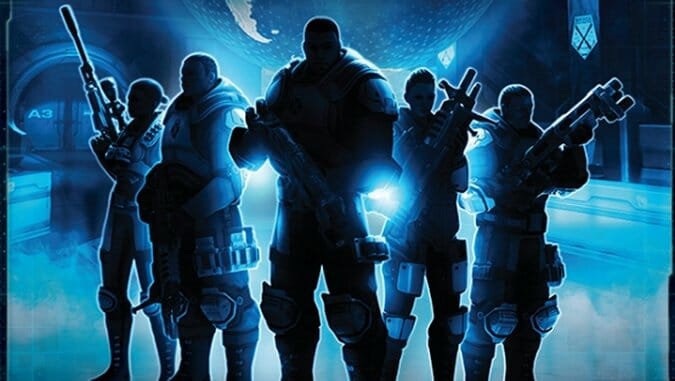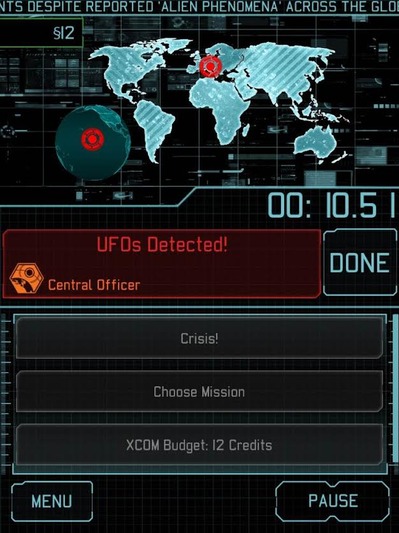
XCOM, the boardgame, is based on a popular and critically acclaimed videogame with the same theme and similar mechanics, but extends the gameplay so that up to four players can assume different roles and work cooperatively to solve the same challenge: to hold off an alien invasion long enough to complete a final “mission” and win the game. It is extraordinarily complex, one of the most complex boardgames I’ve ever encountered, and would probably be unmanageable without the required (free) companion app to guide you through gameplay. The app tells you who needs to make which decision while also adding directions for advancing the alien invasion, all while operating with a timer that adds to the game’s intensity but also prevents it from becoming a three-hour monolith.
In XCOM, players represent the leaders of a global defense force working to slow down the pace of an invasion long enough for the game to allow the players to try to defeat the final mission, a specific and difficult trio of challenges to which the players must devote significant resources. That’s the essence of the boardgame itself: players have very limited resources for the entire game, and have to decide from the first turn how much to put into defense (lest the world be overrun), how much to put into solving short-term missions (for immediate benefits and to advance more quickly to the final mission), and how much to put into researching new technologies that might make future turns easier. Every unit deployed on a turn—soldier, satellite, interceptor (jet), researcher—costs one credit, with a typical budget for a turn starting at ten to twelve credits. With UFOs already on several continents, one or two aliens attacking your base, a short-term mission, three research tasks asking for your attention, and two or maybe three crisis cards just to make everything worse, you’d be forgiven for thinking you’re good and well screwed before you’ve even rolled a single die.
All conflicts in XCOM are resolved via dice: One to four of yours, and one eight-sided alien die that you compare to the “threat level” (from one to five) to see if your task fails automatically. For example, if you have two fighter jets (interceptors … whatever, any three-year-old is going to look at the pieces and call them planes) attacking the three UFOs currently over Europe, you would roll two of your six-sided dice and the alien die. If you get a success token, which appears on two of the six sides of each of your dice, you have destroyed one UFO. The threat level begins at 1 with your first roll, and if you roll a 1 on the alien die, well, tough tentacles—you still destroy any UFOs if you rolled success tokens, but your jets are also destroyed and you’ll have to buy them back later in the game. If not, you increase the threat level to 2 and roll again. This means every roll/stop decision is based on the probability of a desirable outcome, but the cost of a failure isn’t analogous to the benefit of a success.

Attacking specific aliens is a bit more involved, as each alien card has two symbols that correspond to symbols on each of the four soldier types—you need a soldier with that ability to fight that particular alien. Some symbols have a yellow disc behind them, which means they can only be attacked by “elite” soldiers; you can reserve one soldier in each round to a special commander card that makes that token elite for the remainder of the game or until he gets himself killed.
The aforementioned research cards can help you skew the odds of dice rolls in your favor, as well as conferring other benefits in different areas. You may get to roll an additional die, or get one reroll of the alien die per turn. Alien cards frequently have special abilities on them to make your life even more difficult, but you can get a research card that cancels those out. Other research cards give you access to more cash, which might be the most important benefit of all, because in my plays I never seemed to have enough credits to do anything but lose more slowly.
After you’ve completed all of your rolls, you assess the damage from everything you didn’t kill. Each continent has a panic level, starting at yellow and advancing through orange to red; when two continents have reached red, the game is over and the app plays a sad trombone. (It doesn’t, actually, but it should.) Each undefeated UFO over a continent raises the panic level by one at the end of a round. Each alien who infiltrated the base and whom you did not defeat increases the damage to the base by one; eventually the base can be destroyed and once again we invoke the sad trombone. This is a game with a lot of ways to lose.
There’s one way to win, however: Defeat the final mission. The app will determine when you get to face it, and like all mission cards the final mission has three elements to it, some combination of defeating an alien and rolling against difficult tasks that have the same symbols that appear on alien cards. You’ll need elite soldiers to do this, and you’ll probably want a stack of ready technologies to help in the fight. Completing a few of the smaller missions presented earlier in the game will get the app to send you to the final mission sooner, which is key because you can reach the final mission and still lose because the app asks you to update the panic meter first. (I’m not bitter about this at all.) You’re going to take a lot of damage along the way; the key to the game seems to be determining how much damage you can stand while still racing through a few missions to get to that final one.
XCOM is one of the most professionally designed and presented games I’ve seen; the board and pieces are high quality and the app itself had to require a significant amount of development, although I wish the help screens were more detailed and a little easier to navigate. The printed rule book that comes with the game is just four pages and describes the initial setup, not the rules, which is probably for the best given the game’s complexity. A solo game still took me about an hour and a half; with friends it could run to two hours pretty easily. You could play this with younger kids, but in that case I would guess it would amount more to the adults giving the kids directions rather than the cooperative element that makes the game more than just a solo experience. You can play without the timer by pausing it as needed, although that would rob the game of some of its intensity (but perhaps make it easier to play with an adult beverage in your hand). It’s a great example of taking a successful videogame and melding it with Pandemic-style cooperative boardgaming, but that same intensity and the sheer number of decisions players have to make means that a session of XCOM can feel a little less like play and a little bit like work. All the more reason to have that adult beverage handy when you’re done.
Keith Law is a senior baseball writer for ESPN.com and an analyst on ESPN’s Baseball Tonight. You can read his baseball content at search.espn.go.com/keith-law and his personal blog the dish, covering games, literature, and more, at meadowparty.com/blog.
